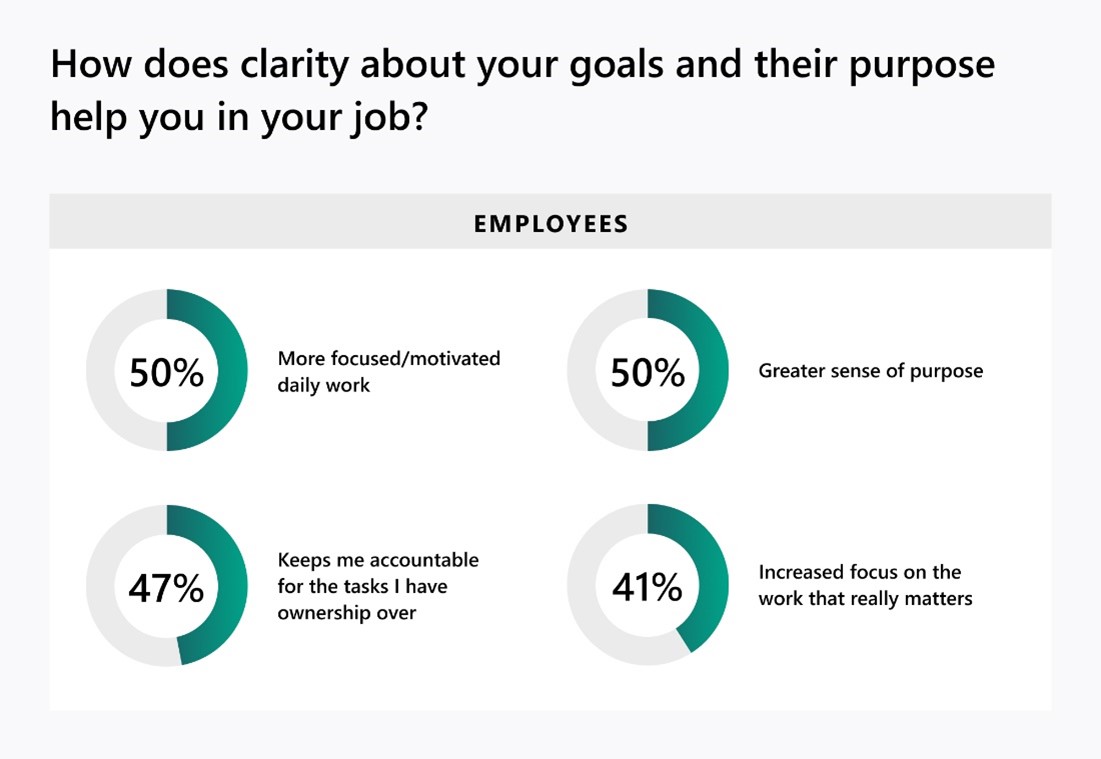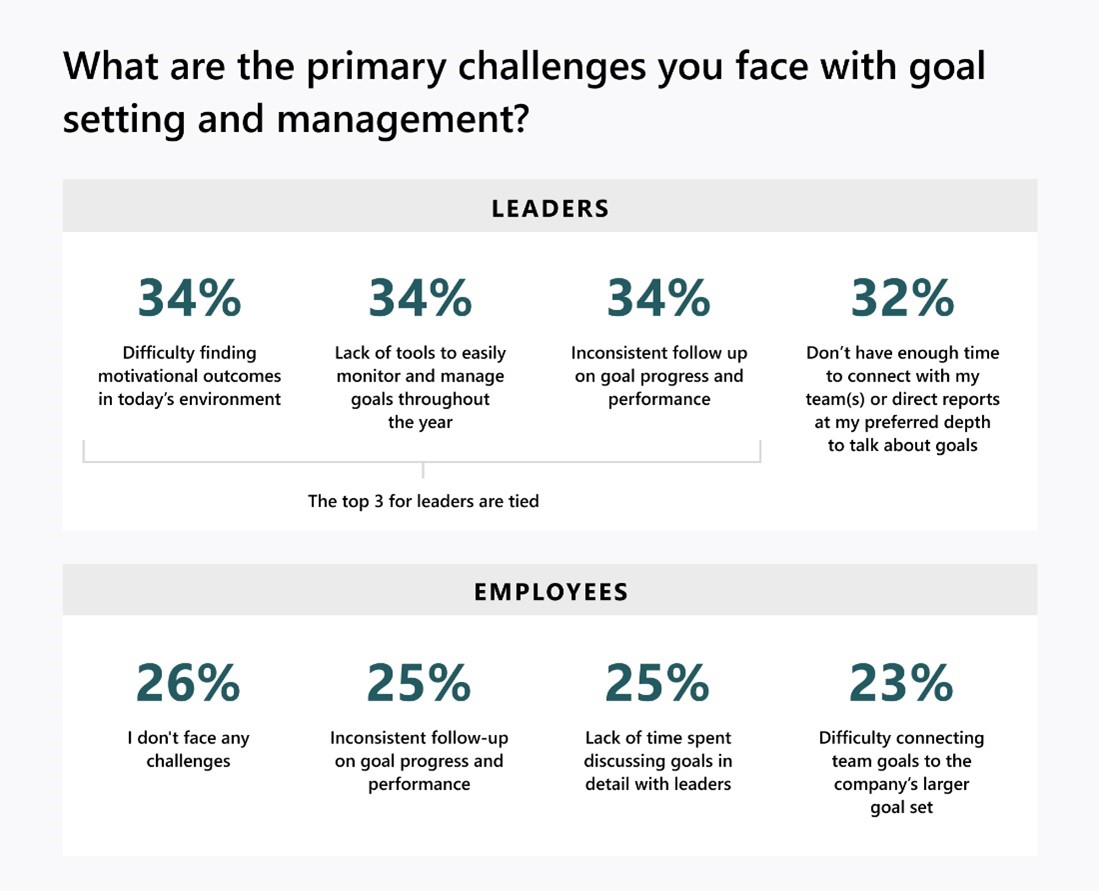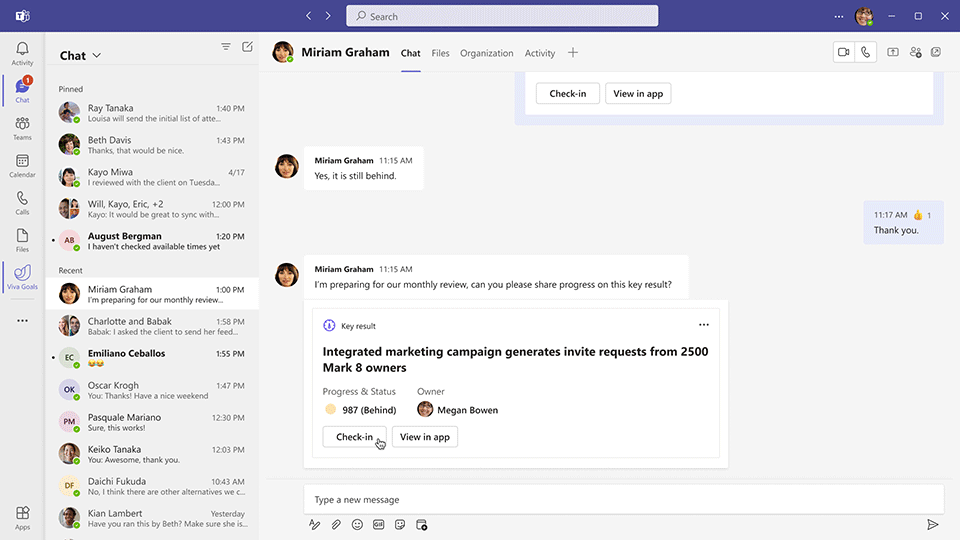2023 is here, which means annual planning and goal-setting are top-of-mind. Maybe you have finalized your business’s goals and are beginning to communicate and act on them. More likely, you’re refining goals or deep in conversations on alignment and prioritization.
In the meantime, your team is ramping back up after the holidays, looking for guidance and motivation as they head into the new year. You want to set the right goals as a team, see progress on an ongoing basis, and focus your team on landing impact.

Microsoft Viva Goals
Create a purpose-driven culture where teams align to achieve results.
From my experience having run multiple organizations and businesses, employees are motivated by having clarity on the goals and the ability to see direct outcomes of their work. So how can organizations provide a goal-setting experience that helps employees work independently, take ownership of their goals, and be motivated day to day while also giving leaders visibility into progress toward business results?
Let’s look at the latest trends in goal-setting, ideas for what to do differently in 2023, and how Microsoft Viva Goals can help.
1. Clarity is the key to stronger impact and more satisfied employees
Employees want clarity around goals more than ever—and it’s good for business. Microsoft commissioned Forrester Consulting to conduct a survey of leaders and employees to ask them about goal-setting within their organizations. Results from the survey will be released in February in the 2023 State of Goal-Setting Report, showing that leaders and employees agree that clearly structured goals lead to motivation, with 47 percent of leaders observing that poorly structured goal-setting reduces individuals’ motivation.
Employee respondents say that goal clarity gives them a greater sense of purpose (50 percent) and motivates them to do daily work (50 percent). Sixty percent of leaders believe that clear and transparent goals motivate employees with a greater sense of purpose. This in turn helps with employee retention.

Figure 1. Base: 209 global enterprise practitioners in retail, healthcare, manufacturing, or financial services with defined goals. Source: A commissioned study conducted by Forrester Consulting on behalf of Microsoft, December 2022.
This is aligned with Microsoft’s latest Work Trend Index data, which found that a majority of employees (87 percent) report they are productive at work, but 85 percent of leaders aren’t so sure. The missing piece here is alignment on what teams are working on and clarity on progress.
Seventy-eight percent of employee respondents in the Forrester 2023 State of Goal-Setting Report fully understand their personal goals, but that number drops significantly for team goals (63 percent) and even further for company goals (39 percent). This highlights the need to clearly define goals and make sure they propagate across all levels of the organization.
How do you ensure that there is a shared understanding of the goals at the company, department, and individual levels and provide clarity on what the objectives are to get there? The clearest way is by using a transparent goal-setting and management process that everyone has access to, which may also be one of the biggest challenges for businesses today.
2. Goal-setting is not a one-time exercise
Goal-setting and management processes often fail because they stay at the leadership level in an ad-hoc, disorganized mix of tooling—think some combination of Excel sheets, PowerPoint decks, Word docs, and meeting notes not everyone has access to—and aren’t translated to the rest of the organization in a way that connects the business’s top priorities to team initiatives. This creates silos between cross-functional teams and a disconnect between what leadership cares about and what employees are actually doing on a daily basis.
Leaders know this disconnect is real. According to the survey results for the 2023 State of Goal-Setting Report, leaders cite their number one challenge with the goal-setting and management process is getting employees involved, while the top two things employees would change in their current goal-setting process are getting more consistent updates and seeing a stronger connection between goals and company outcomes.

Figure 2. Leaders: 429 global enterprise people managers and director decision makers in retail, healthcare, manufacturing, or financial services with defined performance goals. Employees: 209 global enterprise practitioners in retail, healthcare, manufacturing, or financial services with defined goals. Source: A commissioned study conducted by Forrester Consulting on behalf of Microsoft, December 2022.
This means that creating cohesion and clarity doesn’t stop at setting goals. Leaders and employees want to connect on goal progress over time, at a regular cadence, and from a central source of truth, including building rituals such as monthly reviews, department-wide goal updates at All Hands meetings, and discussing goals in team meetings and one-on-ones.
Microsoft Viva Goals is making the connection between goals and daily work easier than ever. We’re enhancing the Viva Goals integration in Microsoft Teams to bring parity between the Viva Goals web app and Teams app, so leaders and employees can receive notifications around objectives and key results (OKR) activity and pin multiple department’s OKRs. In addition, to bring goal-setting into the flow of everyday conversations, users can create, edit, and make check-ins to OKRs directly in the Teams chat.

3. The OKR framework is number one for impact
The survey for the 2023 State of Goal-Setting study found that the OKR framework is the most commonly used framework for leaders, offering a consistent methodology for setting goals that the whole organization can snap to, and one that motivates teams while including measurable results for accountability and encouraging a growth mindset.
According to the 2023 Forrester State of Goal-Setting Report, 73 percent of leaders using OKRs say clear goals and outcomes alleviate some pressure on them to achieve team and organization goals because it helps direct reports focus on the work that matters most, versus only 55 percent of leaders using other methodologies.
The new year is a great time to introduce employees to a different way of doing things and begin to roll out the necessary communications and training for OKRs.
Viva Goals now has a new Analytics feature which helps inform and accelerate OKR deployments. This capability allows organization administrators to view OKR adoption metrics across their organization, including total users, teams and OKRs, active users, check-ins, and more so they can understand how engagement with goals is progressing.
4. Employees are reflecting on how to grow out of their comfort zones
According to the survey results of the upcoming 2023 State of Goal-Setting report, one of the top questions on the minds of employees as they head into 2023, selected by 44 percent of respondents, is “What are the skills I have and the skills I need right now?” In an era where businesses are being asked to do more with less, learning and growth is a major multiplier at the business level, too, helping employees grow so your business can accelerate.
Setting goals around learning and development can take many forms. You can set goals around the completion of training courses you assign based on individual employee interests and the needs of the business, or around learning from cross-functional teams and sitting in on a certain number of customer calls. It’s important that employees understand the why behind these goals—how learning and development will move the needle for them as professionals and the collective team. Microsoft Viva Learning is making this easier with new learning paths and learning collections.

Viva Learning
Empower employees to prioritize their growth and development.
New year, new goals with Microsoft Viva Goals
In 2023, information, data, and hybrid teams will be spread across various geographies, systems, and technology stacks. Unifying and contextualizing the most important information through a centralized, digital OKR system like Microsoft Viva Goals that integrates with already existing employee rhythms gives leaders and employees the visibility to be agile and make decisions with autonomy. By integrating within an employee experience platform like Microsoft Viva, OKRs no longer exist in a silo separate from the employee experience and where people work.
When clarity, alignment, focus, and integration within the employee workflow come together, teams feel connected to purpose and ready to make an impact—no matter where they work or how the world changes.
To help your organization embrace these trends, we’re excited to share new features in Viva Goals to meet your business and employees exactly where you are today when it comes to goal-setting and management, including:
- Security and scalability built for the global enterprise: European Union data residency, availability in 37 languages coming soon, Conditional Access, Google federation in Microsoft Azure Active Directory (Azure AD), as well as Okta federation in Azure AD, all give Viva Goals the secure and global-ready features you’ve come to expect from Microsoft.
- Continued commitment to deep integrations for accelerated OKR adoption: With a fully featured Teams app, as well as integrations with Microsoft Planner, Power BI, Microsoft Dynamics 365, Excel bulk import, and Microsoft Project, you can connect your organization and team goals with the systems of record you are already working in.
- Flexibility based on your business’s OKR maturity: Features like Baseline KRs provide additional flexibility with OKR adoption by allowing a user to create a key result without having a target; phased targets enable nonlinear progress tracking depending on your need to pivot regularly as a business and the granularity at which you like to track progress.
- Powerful visuals to provide admins goal-setting insights: With the Analytics feature, organization administrators are empowered with metrics from adoption, engagement, and OKR health to understand progress.
To learn more about our latest product releases from Microsoft Viva, check out our breaking announcements here: